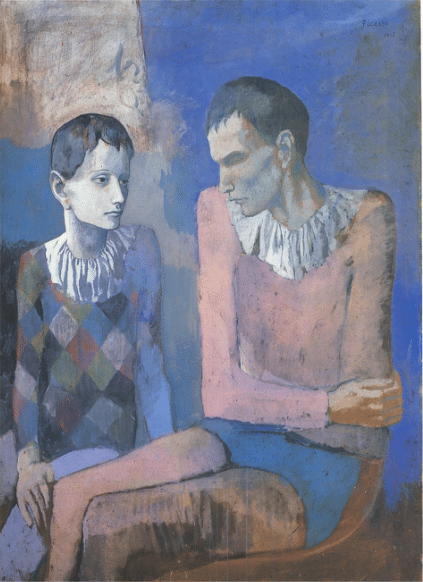
1905, gouache
Drawings and paintings are the two media that Picasso most often used, and, as you know, an entire cottage industry has been created around them, chiefly in the form of scholarship and marketing. But there is also a lot that could be said, and hasn’t yet been, about collecting them.
As usual, it may be useful to begin with a semantic distinction. “Works on paper” is the term usually accorded to any unique work of art created on or at least attached to paper. The terms “drawings” and “works on paper” are often used interchangeably in common parlance, despite the clear understanding that many works on paper are not drawn, but painted. Ordinarily, that is, outside the elite world of fine art collecting, we think of drawing as something created with a pen, pencil, charcoal, or crayon. (In French, even this distinction is blurred because pencils and crayons alike are generically termed “crayon”.) Pastels and oil sticks are clearly also drawing materials. But some paintings, such as in Picasso’s case, oil, gouache, and tempera, as long as they’re on paper, would be classified as works on paper in this schema, despite the fact that they were created with a brush. Even watercolors and ink washes, though they are painted with a brush, are categorized as works on paper.
On the margins of this schema is the special case of Picasso’s occasional charcoals on canvas, which are also typically classified as works on paper, at least on Artnet (see below). As a practical matter, they are usually large and often beautiful and important works, and their price point is usually high enough, as to anyway be included in the auction’s storied evening sale rather than the works on paper sale the following day, thereby dodging this classification issue.
Of course Picasso, who made a point of not following any rules, often mixed his media, so that a given unique work might contain just about any combination of the above materials, however improbably. And paper cut-outs, swatches of fabric, and found objects are also famously a part of his mix.
One practical distinction between works on paper and oils on canvas is that the former should be protected behind glazing, whereas the latter are generally framed “naked”. With nothing between the art and the viewer, the appreciation of the art is a more direct experience. That said, however, with proper low-glare glazing, the works on paper do not appreciably diminish in the viewing.
Well, I hope that was for the most part painless. Now that we have these definitions out of the way, we’re ready to take a look at the current Picasso drawings market (read “Picasso works on paper”). The first salient observation to emerge from any in-depth analysis of this market is the scarcity of available masterpieces. It behooves a collector to understand that although there are buyers for all Picassos, and all original Picassos are collectible, not all Picassos are “created equal”. In fact, in terms of their artistic merit if not their historical significance, lots of Picasso drawings are trash, mere sketches with little artistic merit that he may have used to develop his thoughts en route to a more finished piece, or just bad, hurried drawings for no apparent reason. In this regard, though I’ve used the following quote elsewhere, it may be useful to do so again here. Bill Rubin, who for almost 30 years was in charge of the Department of Painting and Sculpture at the Museum of Modern Art in New York, famously said, “Picasso has probably made more bad pictures than any other serious artist in history. He has also made more masterpieces than any other serious artist in history….” There are certainly so very many artists who created worse art, and those who never made any good art at all. Rubin’s aphorism makes sense when one considers that Picasso’s output was so prodigious that even his failures outnumbered those of other artists. After all, he was an experimentalist who drew and painted rapidly, tirelessly, and over the course of a very long career.
If we especially consider those masterpiece drawings that may be yet attainable, albeit at high if not stratospheric prices, we further narrow the playing field. Since one woman’s ceiling is proverbially another woman’s floor, you can define the term “stratospheric” for yourself and find the price level where you feel most comfortable. Picasso drawings today still start in the four figures, but those are generally rather lackluster sketches. If by stratospheric you mean anything over five figures, or even if you mean anything over seven figures, there are still such Picasso works on paper.
To start with an example off the top shelf, at the time of this writing the world’s record auction sale for a Picasso work on paper is $38 million and change, which is what it took to acquire the 1905 Rose Period gouache, Acrobate et Jeune Arlequin, an oversized, 105 cm work, huge by Picasso drawing standards (see illustration above).
A number of other works on paper have sold in the teens of millions, including two colorful Rose Period gouaches and one yellow and black watercolor, gouache, and an India ink work on paper of 1907, Nu Jaune, related to the Demoiselles d’Avignon:
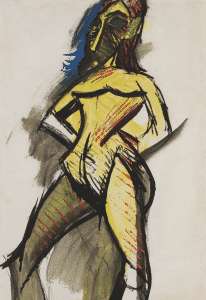
For black-and-white, a record set in 2003 of just under $10 million (and since surpassed) is actually a charcoal on canvas, the incredible 1932 Nu Couché:
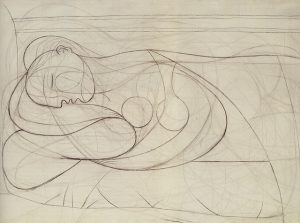
Despite its linen matrix, Artnet classifies it, as mentioned above, as a work on paper. That makes sense, since it probably makes a better bedfellow with other drawings than with oil paintings. The charcoal the artist used to create this work trumps the paper/canvas distinction, as it should. Since drawings are classified as works on paper and the charcoal is fundamentally a drawing, ultimately this charcoal on canvas belongs in the works on paper category even though it isn’t on paper.
As usual, the market accords an (undeservedly) large premium to drawings in color. though naturally a great black-and-white one commands a high price. You may be interested in the record, strictly speaking, for a black-and-white drawing on paper without any traces of white or gray paint, nothing in this case but a graphite pencil. Well, that would be the 1920 Portrait d’Olga which I have blogged elsewhere but illustrate again here:
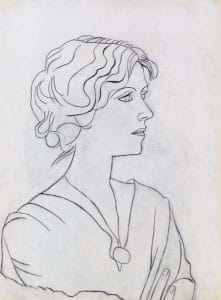
At the other end of the spectrum (omitting the extreme cases of four-figure drawings which, in general, are not worth considering) are the five-figure drawings, typically title pages of exhibition catalogues or artist’s illustrated books that Picasso often dedicated to friends or acquaintances. These are commonly short on quality and long on the prominence of the signature, but some of these works are quite nice. For example, take a gander at this amusing owl:
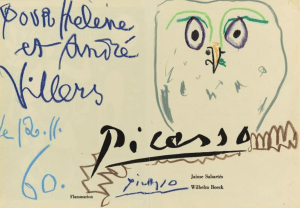
We tend to buy drawings in the middle range…. The middle range, which for the purpose of discussion I define as the lower- to mid-six figures (USD), is what it takes to snag true works on paper masterpieces by Picasso that still seem affordable for us. For several illustrations, I’ll refer you to our online sales catalogue pages.
The prices of Picasso drawings seem more random than those of his prints, for the simple reason that there can be no exact comparison for any unique work. Thus, the marketplace for his “uniques” (that is, drawings and paintings) is by nature in disequilibrium. This is good news, because it provides an opportunity for arbitrage. There will be times when you will appreciate the value of a piece much more than the market at large, and, if you’re right, that would seem to present a buying opportunity. It’s my job, however, to make sure you’re right.
So…how do we valuate Picasso drawings? Not surprisingly, with much the same approach I delineated for Picasso’s prints. As usual, one must first be certain that one is dealing with original drawings. The web and brick-and-mortar storefronts are rife with Picasso reproductions masquerading as original works. As with prints, always be sure to get a catalogue raisonné reference number and dimensions, and then confirm that the vendor’s information is factual. (One place to start is to ask the seller to show you, or send you a scan of, the corresponding page of the catalogue raisonné.) But unlike Picasso’s original prints, which have been exhaustively catalogued, hitherto unknown Picasso works on paper are still emerging today, especially minor works, at a regular clip. If the drawing is not included in the latest and most comprehensive catalogue raisonné, The Picasso Project edited by Wofsy, the only alternative to establish value today is to obtain a signed photocertificate of authenticity from Maya Widmaier Picasso and/or Claude Picasso. They are two of his children and the only people in the world who have the legal authority to authenticate his unique works. Marina Picasso, one of his grandchildren, has sold a part of her inheritance and generally has a stamp that bears her name on the back of her prints and works on paper. But her Picassos are typically already catalogued. Unlike Maya and Claude, she doesn’t authenticate works that have surfaced and been brought to her attention. Without inclusion in at least one catalogue raisonné or authentication by Maya or Claude, the authenticity of the drawing can’t be proved and it becomes impossible to sell for anything close to the value it would command if it were real, unless the seller finds an unsuspecting newbie collector who is prepared to make a costly mistake without engaging in the most basic due diligence. (The most famous example of two such buyers is the sale of the fake Picasso drawings at Costco—see my blog on this subject.) The “PiCostcos” add insult to injury because not only were they worthless fakes, but also, even if they were real, they would still be bad Picassos.
The process of deciding to acquire a particular drawing typically begins for me with an immediate, direct, overwhelming, even transcendental gestalt experience, in which I am thunderstruck by the beauty of the piece and can hardly think of anything else. Then the process of due diligence sets in, in which I scrutinize the work, evaluate it up close and at a distance, dissect it into its component parts, and in turn evaluate each of them in depth. In so doing, I rate the drawing along a number of parameters similar to the ones I use to rate his original prints. Instead of delineating that rating schema at length, I would refer you to the discussion elaborated in Chapter 4 of A Guide to Collecting Picasso’s Prints. In brief, my selection criteria are as follows: beauty, significance, rarity, size, visibility at a distance, color, susceptibility to fading, value (or price relative to comparable Picassos), desirability to cost ratio, and signature. All of these parameters also apply to unique works, provided that by “rarity” we mean the rarity of comparable Picasso drawings. The other exception is the presence or absence of a signature, which is much less important in the world of Picasso drawings than among his prints. (And signatures have been statistically demonstrated to have no relevance to the prices of his oil paintings, as I will get to later.)
The focus of our acquisitions has been the very top-notch drawings, the crème de la crème, the 10 out of 10, in short, the most dramatic and sensational masterpieces. My modus operandi is to buy (and promote) the best Picasso drawings for the money, that is, the best of each type of drawing, the best in each price category, the exemplars of each period, and the ones most riveting, awe-inspiring, meaningful, and drop-dead beautiful to look at. As a result, our works on paper purchases are in each case exemplary and quite worthy of acquisition by a collector with the highest standards.
I have to report, however, that it is very difficult, and ever increasingly so, to find works for sale of this caliber and at reasonable prices and in our price range on the market today. Whatever your preferred price level, it is apparent that museums and important collectors are sucking the best drawings out of circulation, usually, in the case of museums, never to reenter the marketplace again. The black hole that museums comprise is a force to be reckoned with by the drawings collector, because great works on paper are progressively vanishing from the market.
I should also note that with Picasso, one’s definition of beauty must of course be broader than simply the beauty of realistic art. But if you’ve read this far, you must be a Picasso lover, and presumably of more than just his more realistic works, so I’m sure I don’t have to belabor this point. And if all you like are his Blue and Rose Periods or earlier, or even his Neoclassical Period (these tend to have the most realistic works), that’s fine, too—after all, his greatness is unsurpassed in those styles as well.
But here’s a criterion that I would urge you not to use: the catchwords of this criterion are “fresh” and “burnt”. I’ve heard these terms so many times now that every incremental instance virtually makes me gag. What exactly am I gagging about? If a drawing has been at auction or at a prominent storefront dealer in the memorable past, the sticklers for fresh meat call it burnt. If a Picasso suddenly emerges from obscurity, having not been seen for decades, it is given the distinction of “freshness”. (This insistence on freshness is thankfully not a part of the print world, but applies equally to the paintings market.) But look, it’s hard enough as it is to find a great Picasso drawing at an affordable price. To insist on top of that that it has to have vanished from the face of the earth for many years is just plain setting the bar too high. What difference does it make? Would the drawing be any less beautiful, or any less important, if many other Picasso lovers had seen it in the recent past? To me, this is just plain silly. Frankly, if many people had seen it, the consensus about its importance should actually increase, as it would if it were a prominently displayed piece in a widely-visited museum. Let’s get real, people—we’re buying Picassos here, not groceries!
Thankfully, it seems that most of the folks who insist on “freshness” are not collectors, but rather art dealers, consultants, and brokers who would naturally prefer that no one else in the trade had recently sold the work at hand—otherwise their buyer might learn its recent price. That wouldn’t be a problem if the seller were not interested in price gouging but would rather make a reasonable profit and close the deal, but it doesn’t always work out that way.
Unfortunately, the fresh-freaks have poisoned the water and convinced some of their clients that they, too, should be concerned about wilted or charred art. If you ask their collectors why they have incorporated these tenets as their own, they probably won’t be able to explain it, hopefully not even to their own satisfaction. So a preliminary discussion about burnt art now needs to take place with any new client who has drunk from the poison well, before the buyer and seller can begin to get down to the real business of selecting the art.
Another way of burning your drawing is by “shopping it around”. By now you must have figured me out enough to anticipate that eliminating a piece from consideration simply because it has been shopped around is an attitude that also annoys me. Shopping the work around may admittedly create a bit of a nuisance for the buyer. The buyer, be it a collector or someone in the trade, may tire of repeatedly seeing the same piece offered to him by various vendors. On the other hand, given a bit of patience, a multiplicity of offers could be construed as an advantage to the buyer, since it affords the buyer the opportunity of choosing the lowest offer.
At this point, I would like to invite you to look at the images of the drawings we own and peruse my online descriptions of them. Please also note that at any point in time we have a number of other drawings (and paintings and original prints) from private sources at our disposal about which I could inform you upon request. Yes, some of these have been burnt to a crisp; others are farm-fresh. And, as long as we’re speaking of sources, if you have a real Picasso drawing (or painting or print) that you would consider selling, please contact us with details. We offer the service of a “virtual consignment”, whereby you keep the art up until the point of sale.